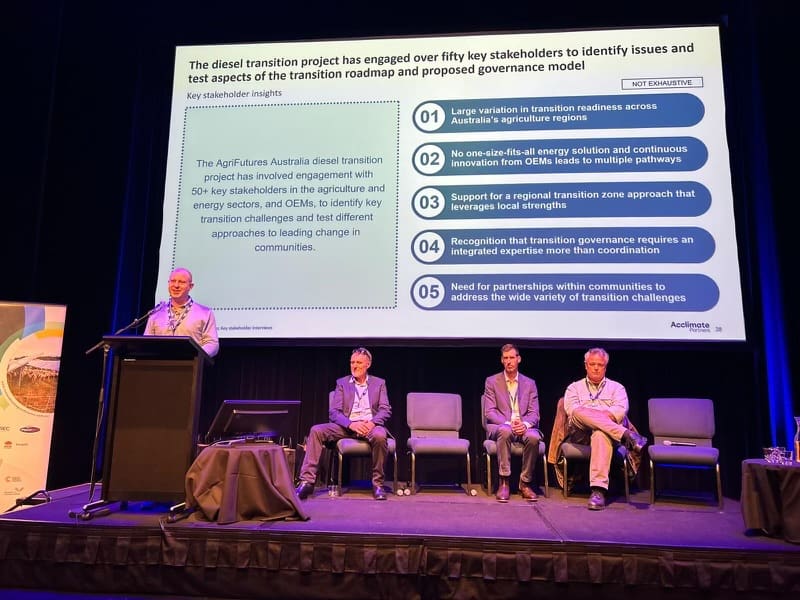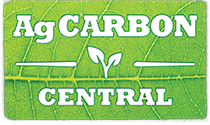
Source: GRDC
CROP residues could emerge as a new marketable commodity for growers as interest increases in low-cost, environmentally friendly feedstock sources for renewable diesel and hydrogen production.
Speaking at the Renewables in Agriculture Conference held in Toowoomba on July 4, Acclimate Partners managing partner Cassian Drew said renewable diesel provided the ideal path away from fossil fuels because they are a “drop-in fuel” for existing vehicles and machinery.
“There will be a role for renewable diesel in Australia, which is chemically the same as diesel but not fossil-based, and what we need to do is increase that supply,” Mr Drew said.
Mr Drew is undertaking a study with AgriFutures to investigate how Australian farmers and heavy industries can transition away from using diesel fuels.
He said the opportunity for renewable fuel sources created “huge potential” for producers of biomass feedstock, such as, oilseeds, crop residues, tallow, and used cooking oils.
Energy transition partner firm Acclimate Partners is also working with communities and businesses to advise on and provide on-the-ground assistance with ongoing and potential projects and investment opportunities.
Fuel versus stubble retention
Out of a total record canola export program of 6 million tonnes in the year to 30 September 2023, Australia exported 2.8Mt to the European Union to help supply its growing renewable fuels market.
In recent years, debate among policymakers and industry has intensified as to the ethics of turning a potential food source into fuel, and Mr Drew said crop waste as a feedstock sidesteps this issue.
However, he said growers will have to contend with a new environmental dilemma; whether to sell crop residue, or retain it as groundcover.
“There is a decision that needs to be made there on retention for soil cover versus energy input, and that’s a farm-level decision,” Mr Drew said.
“I think we are really quickly going to max out oilseeds and we need to move into…biomass, which will open up a whole new landscape.”

Acclimate Partners managing partner Cassian Drew speaking at the Renewables in Agriculture conference in Toowoomba. Photo: Acclimate Partners
Supply chain coordination
Unlike the systems to move oilseed and cereal crops from farms to processors, there is no supply chain set up to collect and transport crop residues to possible refinery sites.
Australia currently has two operating refineries, Viva Energy’s Geelong Oil Refinery in Victoria and Ampol’s Lytton Oil Refinery in Queensland, which could move to biofuel manufacturing.
One closed facility, bp’s Kwinana Oil Refinery, is already in the process of pivoting to produce sustainable aviation fuel and renewable diesel.
Mr Drew said his work is currently exploring the means of coordinating the collection of feedstocks to transport to existing or newly constructed large-scale refineries.
He said the strategy would include the creation of “nodes”, similar to storage sites currently operated by bulk handlers, that would be regional collection points for residues.
“It is how you get that [biomass] into a refinery into Western Australia or a refinery in Brisbane that is going to make these regions price-competitive as an input supplier.
“How do you go from a paddock to a node point…and that’s where we need to be next.”
Mr Drew said government, industry and advocacy groups needed to partner with growers and regional communities to enable these projects to reach scale.
“There is a great deal of support for a local community-led place-based approach to transition that really leverages local strengths, and that includes the availability of local feedstocks, the availability of infrastructure, of skills etc.”
Start-up progresses tech
Australian hydrogen technology startup HydGene Renewables is one company currently working on engineering solutions to transform biomass into products including green fuels.
HydGene Renewables chief executive officer and founder Louise Brown also presented at the Renewables in Ag Conference.
She said the company was targeting the development of smaller-scale on-farm modules which would convert biomass, such as crop residues, into hydrogen and green ammonia.
Ms Brown said a key aim for HydGene was to build on-farm green ammonia production modules for farmers.
“We have coupled up with two technology providers, one is a company in the UK called Nium that has another biocatalyst technology for taking hydrogen to ammonia, so we can start to have production of ammonia on site, on-farm using biomass residues,” Ms Brown said.
She said the company was also working with University of Newcastle to help “scale down” the Haber-Bosch process, the method for the production of ammonia, “to start to get some smaller modular units on-farm”.
HydGene currently has an in-house pilot plant which can produce one kilogram of hydrogen per day and is working to scale up to commercial production of 1-10 tonnes per day by 2028.
Ms Brown said the company has partnered with cattle producer Tait Pastoral Company at Mandurama in the Central West of New South Wales to commence a field-pilot program from next year.
“There is a lot of opportunity for the ag sector to become involved.”
Ms Brown said HydGene had already completed testing on a range of feedstocks including crop residues, cotton-gin trash, woodchips, paper waste, and human sewage.
She said biomass, especially on-farm waste, was “not the limiting factor” for getting these projects to scale, but it was the “willingness to build some of these larger plants in Australia”.
“If we could take all the excess straw stubble from the wheat industry that is burnt annually each year, you can double the amount of hydrogen that is made from fossil fuels in Australia.”
Ms Brown said using agricultural waste also made for a lower-cost fuel source, depending on which feedstock was used, and the distance between the farmgate and processing plant.
“About two-thirds of the price for the hydrogen is what you are feeding it with, so if you work with something like wheat-straw stubble, there is a cost for the farmer to collect that.”
She said as an example, wheat stubble could cost $100-$120/t in some regions to purchase and transport to a facility.
Grain Central: Get our free news straight to your inbox – Click here

HAVE YOUR SAY